Discover 50 hidden attractions, cool sights, and unusual things to do in Canada. Don't miss out on these must-see attractions: Horseshoe Falls (Niagara Falls), Skylon Tower (Niagara Falls) or Stanley Park (Vancouver).
Below, you can find the list of the most amazing places you should visit in Canada.
Table of Contents
Horseshoe Falls, Niagara Falls
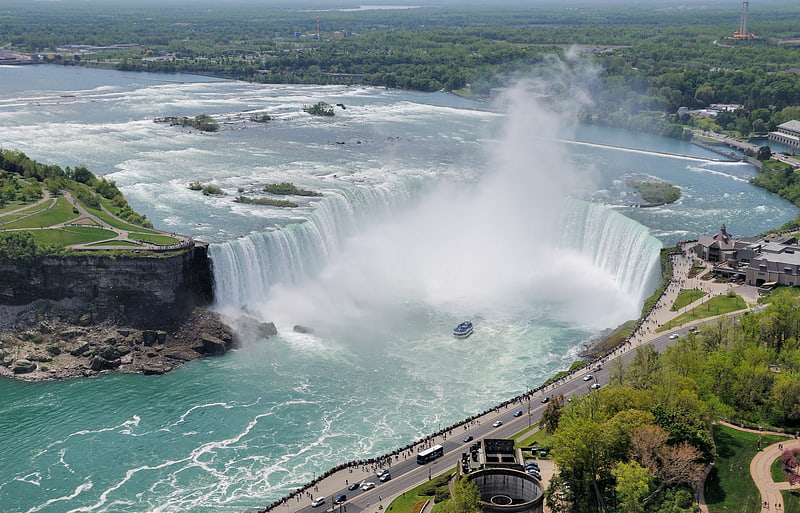
Waterfall in Ontario, Canada. Horseshoe Falls, also known as Canadian Falls, is the largest of the three waterfalls that collectively form Niagara Falls on the Niagara River along the Canada–United States border. Approximately 90% of the Niagara River, after diversions for hydropower generation, flows over Horseshoe Falls. The remaining 10% flows over American Falls and Bridal Veil Falls. It is located between Terrapin Point on Goat Island in the US state of New York, and Table Rock in the Canadian province of Ontario.[1]
Address: Horseshoe Falls, Niagara Falls
Skylon Tower, Niagara Falls
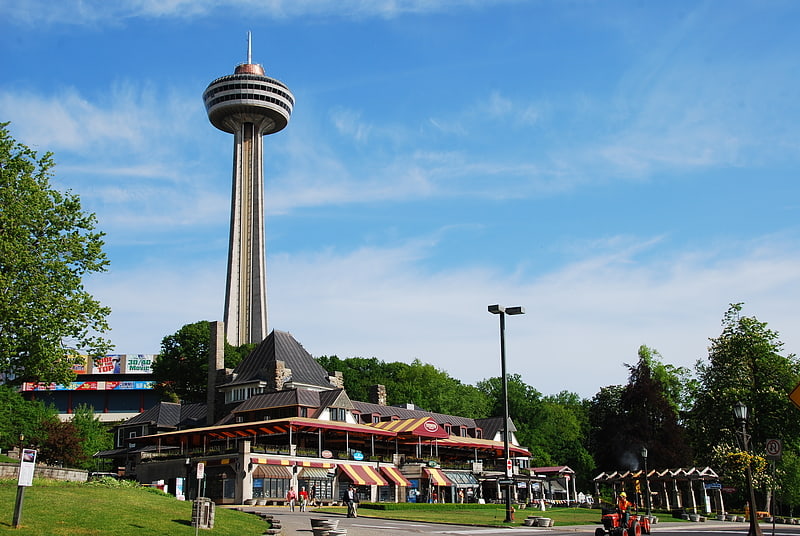
Waterfall views and a revolving eatery. The Skylon Tower, in Niagara Falls, Ontario, is an observation tower that overlooks both the American Falls, New York, and the larger Horseshoe Falls, Ontario, from the Canadian side of the Niagara River.[2]
Address: 5200 Robinson St, L2G 2A3 Niagara Falls (Queen Victoria)
Stanley Park, Vancouver
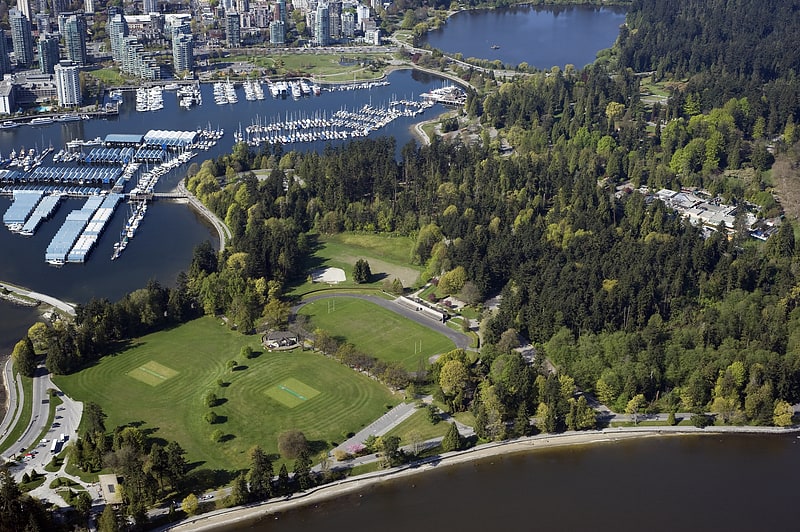
Sprawling urban park with scenic seawall. Stanley Park is a 405-hectare public park in British Columbia, Canada that makes up the northwestern half of Vancouver's Downtown Peninsula, surrounded by waters of Burrard Inlet and English Bay. The park borders the neighbourhoods of West End and Coal Harbour to its southeast, and is connected to the North Shore via the Lions Gate Bridge. The historic lighthouse on Brockton Point marks the park's easternmost point. While it is not the largest of its kind, Stanley Park is about one-fifth larger than New York City's 340-hectare Central Park and almost half the size of London's 960-hectare Richmond Park.
Stanley Park has a long history. The land was originally used by Indigenous peoples for thousands of years before British Columbia was colonized by the British during the 1858 Fraser Canyon Gold Rush and was one of the first areas to be explored in the city. For many years after colonization, the future park with its abundant resources would also be home to non-Indigenous settlers. The land was later turned into Vancouver's first park when the city incorporated in 1886. It was named after Lord Stanley, 16th Earl of Derby, a British politician who had recently been appointed Governor General. It was originally known as Coal Peninsula and was set aside for military fortifications to guard the entrance to Vancouver harbour. In 1886 Vancouver city council successfully sought a lease of the park which was granted for $1 per year. In September 1888 Lord Stanley opened the park in his name.
Unlike other large urban parks, Stanley Park is not the creation of a landscape architect, but rather the evolution of a forest and urban space over many years. Most of the manmade structures present in the park were built between 1911 and 1937 under the influence of then superintendent W.S. Rawlings. Additional attractions, such as a polar bear exhibit, aquarium, and a miniature train, were added in the post-war period.
Much of the park remains as densely forested as it was in the late 1800s, with about a half million trees, some of which stand as tall as 76 metres (249 ft) and are hundreds of years old. Thousands of trees were lost (and many replanted) after three major windstorms that took place in the past 100 years, the last in 2006.
Significant effort was put into constructing the near-century-old Vancouver Seawall, which can draw thousands of people to the park in the summer. The park also features forest trails, beaches, lakes, children's play areas, and the Vancouver Aquarium, among many other attractions. On June 18, 2014, Stanley Park was named "top park in the entire world" by TripAdvisor, based on reviews submitted.[3]
Address: Stanley Park Dr, V6G 3E2 Vancouver
Art Gallery of Ontario, Toronto
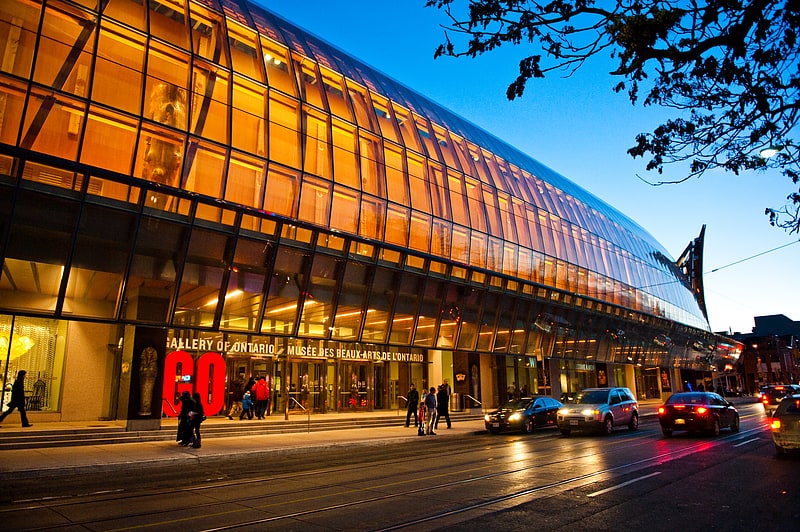
Famous Canadian art and Gehry renovation. The Art Gallery of Ontario is an art museum in Toronto, Ontario, Canada. The museum is located in the Grange Park neighbourhood of downtown Toronto, on Dundas Street West between McCaul and Beverley streets just east of Chinatown. The museum's building complex takes up 45,000 square metres of physical space, making it one of the largest art museums in North America and the second-largest art museum in Toronto after the Royal Ontario Museum. In addition to exhibition spaces, the museum also houses an artist-in-residence office and studio, dining facilities, event spaces, gift shop, library and archives, theatre and lecture hall, research centre, and a workshop.
Established in 1900 as the Art Museum of Toronto, and formally incorporated in 1903, it was renamed the Art Gallery of Toronto in 1919, before it adopted its present name, the Art Gallery of Ontario, in 1966. The museum acquired the Grange in 1911 and later undertook several expansions to the north and west of the structure. The first series of expansions occurred in 1918, 1924, and 1935, designed by Darling and Pearson. Since 1974, the gallery has undergone four major expansions and renovations. These expansions occurred in 1974 and 1977 by John C. Parkin, and 1993 by Barton Myers and KPMB Architects. From 2004 to 2008, the museum underwent another expansion by Frank Gehry. The museum complex saw further renovations in the 2010s by KPMB and Hariri Pontarini Architects.
The museum's permanent collection includes over 120,000 works spanning the first century to the present day. The museum collection includes a number works from Canadian, First Nations, Inuit, African, European, and Oceanic artists. In addition to exhibits for its collection, the museum has organized and hosted a number of travelling art exhibitions.[4]
Address: 317 Dundas St W, M5T 1G4 Toronto (Downtown Toronto)
CN Tower, Toronto
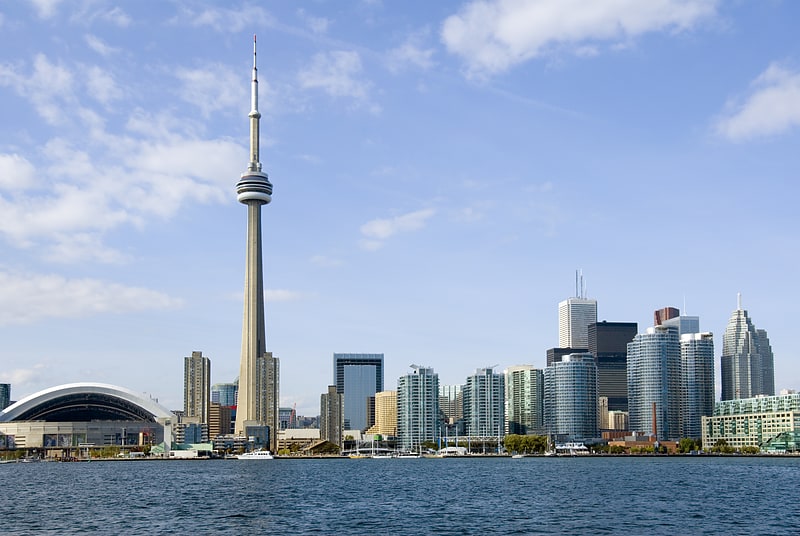
Iconic tower with a revolving restaurant. The CN Tower is a 553.3 m-high concrete communications and observation tower in downtown Toronto, Ontario, Canada. Built on the former Railway Lands, it was completed in 1976. Its name "CN" referred to Canadian National, the railway company that built the tower. Following the railway's decision to divest non-core freight railway assets prior to the company's privatization in 1995, it transferred the tower to the Canada Lands Company, a federal Crown corporation responsible for real estate development.
The CN Tower held the record for the world's tallest free-standing structure for 32 years, from 1975 until 2007, when it was surpassed by the Burj Khalifa, and was the world's tallest tower until 2009 when it was surpassed by the Canton Tower. It is currently the ninth-tallest free-standing structure in the world and remains the tallest free-standing structure on land in the Western Hemisphere. In 1995, the CN Tower was declared one of the modern Seven Wonders of the World by the American Society of Civil Engineers. It also belongs to the World Federation of Great Towers.
It is a signature icon of Toronto's skyline and attracts more than two million international visitors annually. It houses several observation decks, a revolving restaurant at some 1,151 feet (351 m), and an entertainment complex.[5]
Address: 301 Front St W, M5V 2T6 Toronto (Downtown Toronto)
Journey Behind the Falls, Niagara Falls

Tourist attraction in Niagara Falls, Ontario. Journey Behind the Falls is an attraction in Niagara Falls, Ontario, Canada located in the Table Rock Centre beside the Canadian Horseshoe Falls. It is open year round and run by the Niagara Parks Commission.[6]
Address: 6650 Niagara Pkwy, L2E 3E8 Niagara Falls (Queen Victoria)
Harbourfront Centre, Toronto
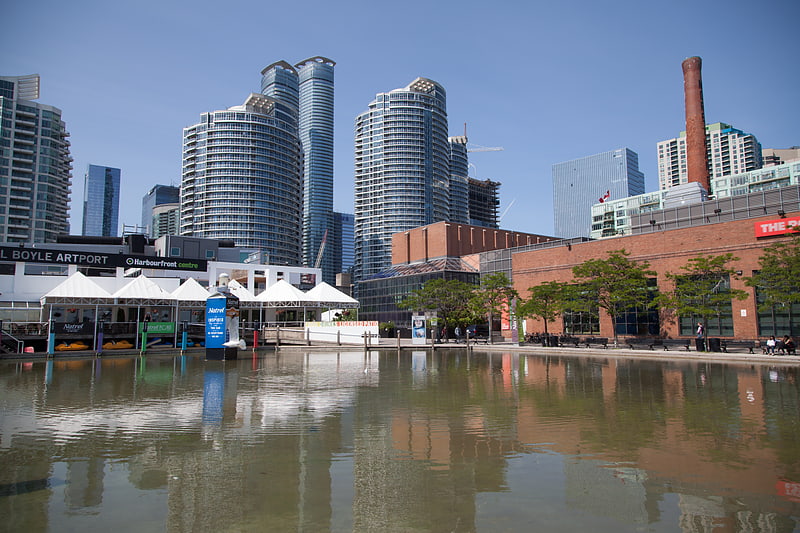
Non-profit organization. Harbourfront Centre is a key cultural organization on the waterfront of Toronto, Ontario, Canada, situated at 235 Queens Quay West. Established as a crown corporation in 1972 by the Government of Canada to create a waterfront park, it became a non-profit organization in 1991. Funding comes from corporate sponsors, government grants, individual donors and entrepreneurial activities. Harbourfront Centre has a seating capacity of 2,000.
Harbourfront Centre works with over 450 community organizations, and hosts more than 4,000 events a year in many disciplines such as theatre, dance, literature, music, film, visual arts and craft. The development is governed by a 26-person community based volunteer Board of Directors, and is assisted by approximately 2,000 volunteers who generously contribute their efforts and time. Harbourfront Centre is patrolled by its own in-house security team, which works closely with police to ensure that the property is protected.[7]
Address: 235 Queens Quay W, M5J 2G8 Toronto (Downtown Toronto)
Science World, Vancouver
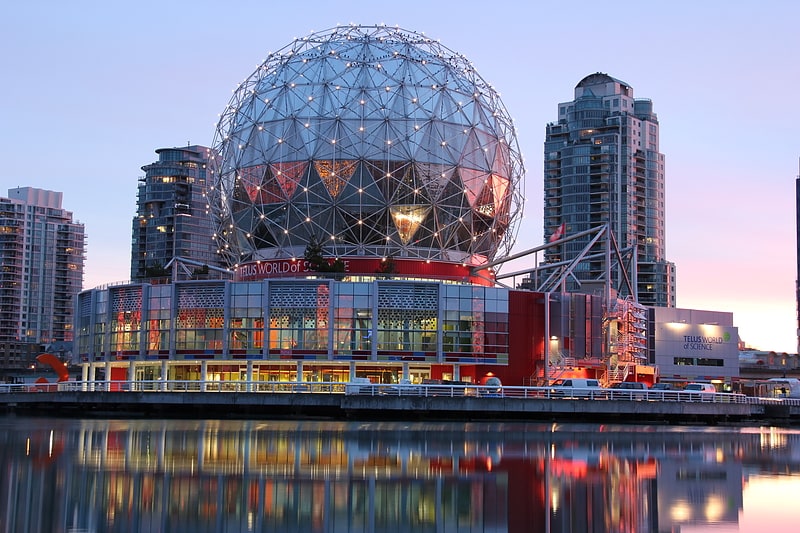
Museum in Vancouver, British Columbia. Science World is a science centre run by a not-for-profit organization of the same name in Vancouver, British Columbia, Canada. It is located at the end of False Creek and features many permanent interactive exhibits and displays, as well as areas with varying topics throughout the years.
Prior to the building being handed over to Science World by the city government in 1987, the building was built as Expo Centre for the Expo 86 world's fair. Following the end of Expo 86, the building was re-purposed as a science centre. The science centre opened on May 6, 1989, as Science World. From 2005 to 2020, the museum was branded as Science World at Telus World of Science, before it reverted to its original name.[8]
Address: 1455 Quebec St, V6A 3Z7 Vancouver
Montreal Science Centre, Montreal
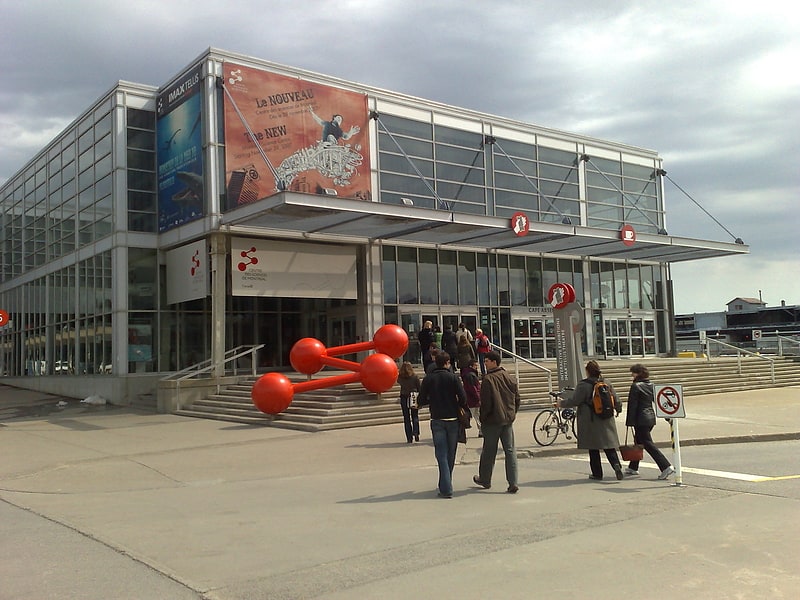
Museum in Montreal, Quebec. The Montreal Science Centre is a science museum in Montreal, Quebec, Canada. It is located on the King Edward Pier in the Old Port of Montreal. Established in 2000 and originally known as the iSci Centre, the museum changed its name to the Montreal Science Centre in 2002. The museum is managed by the Old Port of Montreal Corporation. The museum is home to interactive exhibitions on science and technology as well as an IMAX theatre.[9]
Address: 2 Rue de la Commune O, H2Y 4B2 Montréal (Ville-Marie District)
Musée d'art contemporain de Montréal, Montreal
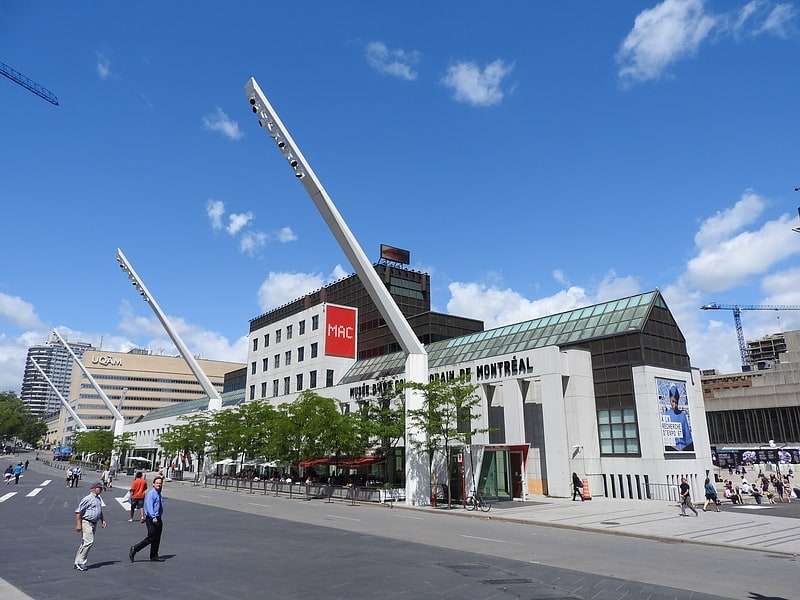
Post-1939 visual works and Québec artists. The Musée d'art contemporain de Montréal is a contemporary art museum in Montreal, Quebec, Canada. It is located on the Place des festivals in the Quartier des spectacles and is part of the Place des Arts complex.
Founded in 1964, it is Canada's first museum devoted to contemporary art. Initially housed in the Place Ville-Marie, the museum moved into the premises of the Château Dufresne in 1965, followed by an exhibition gallery from Expo 67 in 1968. In 1992, the museum moved to its current premises at Place des Arts in Montreal.[10]
Address: 185 Rue Sainte-Catherine O, H2X 3X5 Montréal (Ville-Marie District)
Montreal Museum of Fine Arts, Montreal
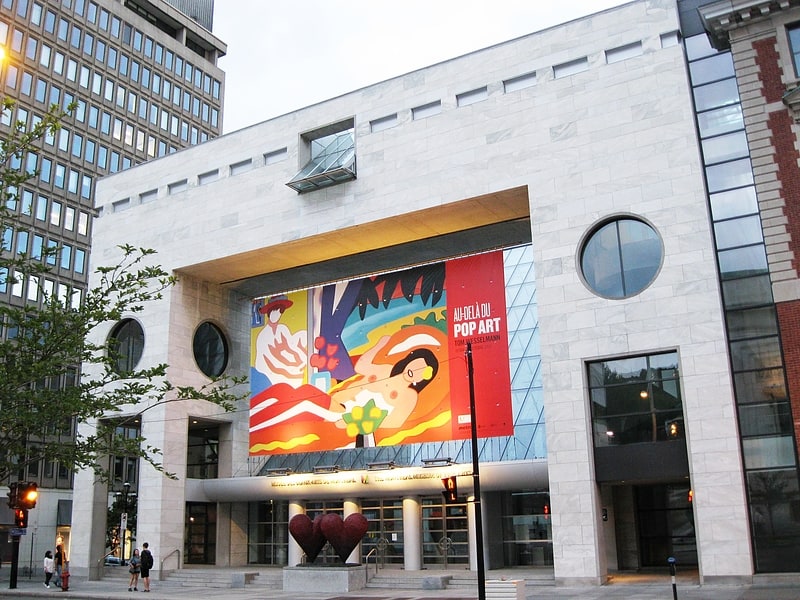
Canadian art and global exhibits. The Montreal Museum of Fine Arts is an art museum in Montreal, Quebec, Canada. It is the largest art museum in Canada by gallery space. The museum is located on the historic Golden Square Mile stretch of Sherbrooke Street.
The MMFA is spread across five pavilions, and occupies a total floor area of 53,095 square metres (571,510 sq ft), 13,000 (140,000 sq ft) of which are exhibition space. With the 2016 inauguration of the Michal and Renata Hornstein Pavilion for Peace, the museum campus was expected to become the eighteenth largest art museum in North America. The permanent collection included approximately 44,000 works in 2013. The original "reading room" of the Art Association of Montreal was the precursor of the museum's current library, the oldest art library in Canada.
The Montreal Museum of Fine Arts is a member of the International Group of Organizers of Large-scale Exhibitions, also known as the Bizot Group, a forum which allows the leaders of the largest museums in the world to exchange works and exhibitions.
Founded in 1860, it is the oldest art museum in Canada. In 2020, it was the most visited art museum in Canada.[11]
Address: 1380 Rue Sherbrooke Ouest, H3G 1J5 Montréal (Ville-Marie District)
Rideau Canal, Ottawa

Canal in Ontario, Canada. The Rideau Canal, also known unofficially as the Rideau Waterway, connects Canada's capital city of Ottawa, Ontario, to Lake Ontario and the Saint Lawrence River at Kingston. It is 202 kilometres long. The name Rideau, French for "curtain", is derived from the curtain-like appearance of the Rideau River's twin waterfalls where they join the Ottawa River. The canal system uses sections of two rivers, the Rideau and the Cataraqui, as well as several lakes. Parks Canada operates the Rideau Canal.
The canal was opened in 1832 as a precaution in case of war with the United States. It remains in use today primarily for pleasure boating, with most of its original structures intact. The locks on the system open for navigation in mid-May and close in mid-October. It is the oldest continuously operated canal system in North America. In 2007 it was registered as a UNESCO World Heritage Site.[12]
Address: Colonel By Dr, Ottawa
Citadelle of Quebec, Quebec City
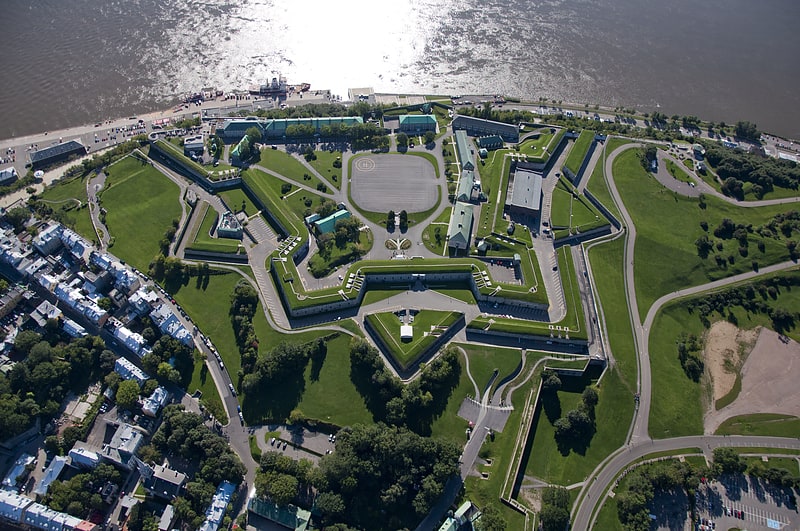
Museum and active fort with a long history. The Citadelle of Quebec, also known as La Citadelle, is an active military installation and the secondary official residence of both the Canadian monarch and the governor general of Canada. It is located atop Cap Diamant, adjoining the Plains of Abraham in Quebec City, Quebec. The citadel contains the oldest military building in Canada, and forms part of the fortifications of Quebec City, which is one of only two cities in North America still surrounded by fortifications, the other being Campeche, Mexico.
The strategic importance of Cap Diamant was recognized by the French as early as 1608. Several defensive fortifications were built on the site first by the French, and then by the British after their conquest of New France. The modern citadel was built from 1820 to 1850, in effort to secure Quebec City against a potential American attack. The British used the citadel until 1871, when they formally handed the property over to the Canadian government. Following the handover, the citadel was used as a military installation by the Canadian Armed Forces, and as a royal and viceregal residence.
The Citadelle is a National Historic Site of Canada and forms part of the Fortifications of Québec National Historic Site of Canada. The fortress is located within the Historic District of Old Québec, which was designated a World Heritage Site in 1985. The site receives some 200,000 visitors annually.[13]
Address: 1 Côte de la Citadelle, G1R 3R2 Québec (La Cite)
Museum of Anthropology, Vancouver
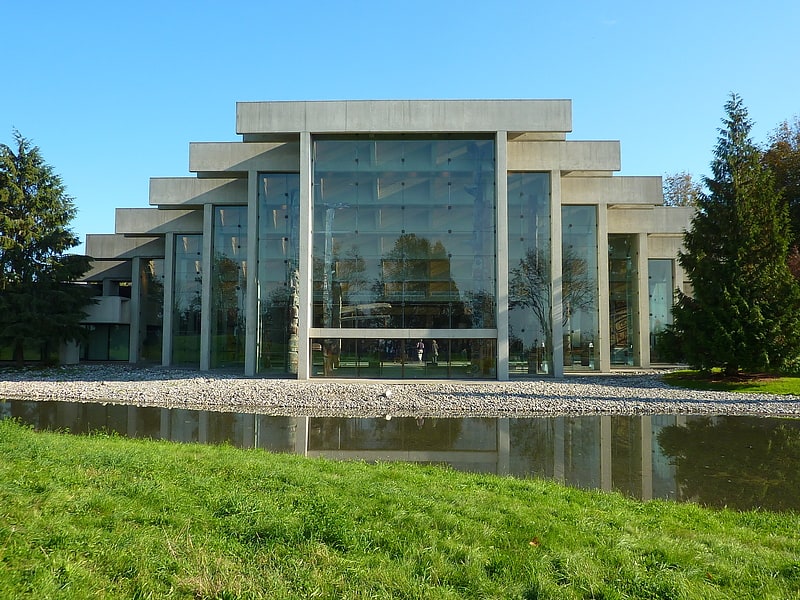
Cultural artworks from around the world. The Museum of Anthropology at the University of British Columbia campus in Vancouver, British Columbia, Canada is renowned for its displays of world arts and cultures, in particular works by First Nations of the Pacific Northwest. As well as being a major tourist destination, MOA is a research and teaching museum, where UBC courses in art, anthropology, archaeology, conservation, and museum studies are given. MOA houses close to 50,000 ethnographic objects, as well as 535,000 archaeological objects in its building alone.[14]
Address: 6393 NW Marine Dr, V6T 1Z2 Vancouver
Royal BC Museum, Victoria
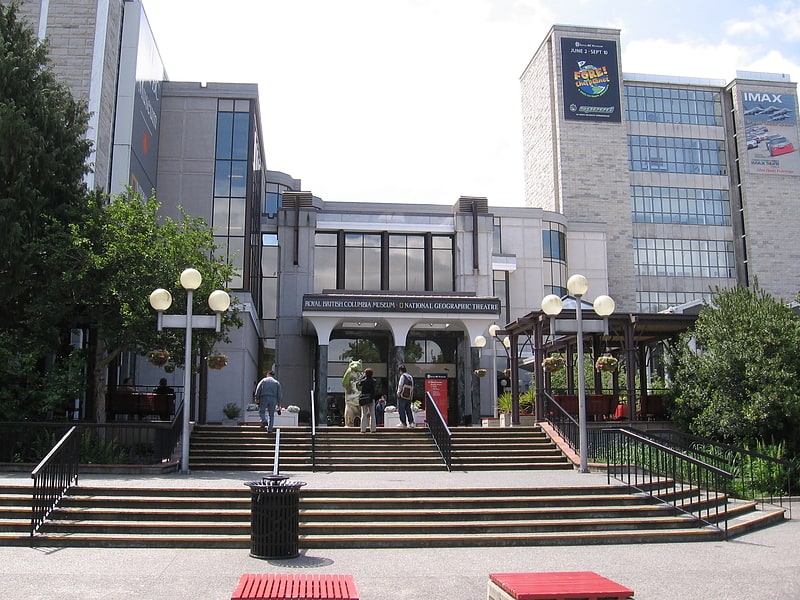
Museum in Victoria, British Columbia. Founded in 1886, the Royal British Columbia Museum consists of The Province of British Columbia's natural and human history museum as well as the British Columbia Provincial Archives. The museum is located in Victoria, British Columbia, Canada. The "Royal" title was approved by Queen Elizabeth II and bestowed by HRH Prince Philip in 1987, to coincide with a Royal tour of that year. The museum merged with the British Columbia Provincial Archives in 2003.
The Royal BC Museum includes three permanent galleries: Natural History, Becoming BC, and the First Peoples Gallery. The museum's collections comprise approximately 7 million objects, including natural history specimens, artifacts, and archival records. The natural history collections have 750,000 records of specimens almost exclusively from BC and neighbouring states, provinces, or territories. The collections are divided into eight disciplines: Entomology, Botany, Palaeontology, Ichthyology, Invertebrate Zoology, Herpetology, Mammalogy, and Ornithology. The museum also hosts touring exhibitions. Previous exhibitions have included artifacts related to the RMS Titanic, Leonardo da Vinci, Egyptian artifacts, the Vikings, the British Columbia gold rushes and Genghis Khan. The Royal BC Museum partners with and houses the IMAX Victoria theater, which shows educational films as well as commercial entertainment.
The museum is beside Victoria's Inner Harbour, between the Empress Hotel and the Legislature Buildings. The museum anchors the Royal BC Museum Cultural Precinct, a surrounding area with historical sites and monuments, including Thunderbird Park. The museum also operates traveling exhibitions which tour the province of BC, as well as international exhibits Guangzhou, China.
On March 26, 2012, Jack Lohman was appointed CEO of the Royal BC Museum. Various groups assist with the development, success, and maintenance of the Royal BC Museum. These include volunteers, who number over 500 and outnumber the Royal BC Museum staff 4 to 1; the Royal BC Museum Foundation (formerly Friends of the Royal BC Museum Foundation), a non-profit organization created in 1970 to support the Royal BC Museum financially and to assist its work by forming links within the community; Security Services, responsible for risk management, emergency response, security services, and business continuity expertise; and Property Management and Operations, who focus on sustainability, recycling, and environment control within the museum.[15]
Address: 675 Belleville St, V8W 9W2 Victoria
Butchart Gardens, Victoria
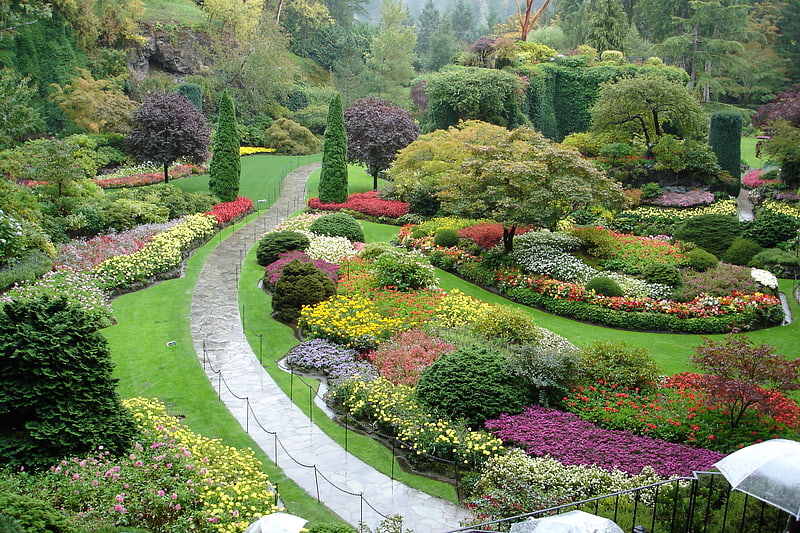
Famous botanical garden. The Butchart Gardens is a group of floral display gardens in Brentwood Bay, British Columbia, Canada, located near Victoria on Vancouver Island. The gardens receive over a million visitors each year. The gardens have been designated a National Historic Site of Canada.[16]
Address: 800 Benvenuto Ave, V8M 1J8 Brentwood Bay
Musée de la civilisation, Quebec City
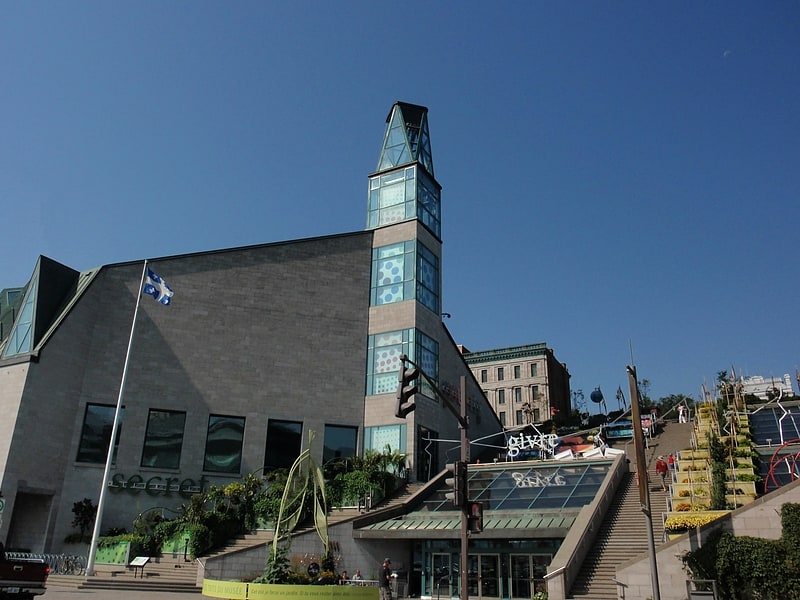
Human societies in Quebec and worldwide. The Musée de la civilisation, often directly translated in English-language media outside Quebec as the Museum of Civilization, is a museum located in Quebec City, Quebec, Canada. It is situated in the historic Old Quebec area near the Saint Lawrence River. It was designed by architect Moshe Safdie, and opened its doors to the public on 19 December 1988.
The previous buildings of the Banque de Paris and the Maison Estèbe, which were situated on Saint-Pierre street, were integrated in the museum's structure. Permanent and temporary exhibitions are held at the museum, usually related to humanities, and virtual exhibitions are also available. The institution also hosts Quartier des découvertes (Discovery Zone), geared towards children, and offers other services such as guided visits, a French America reference centre, shows, souvenir boutiques, a cafeteria, and a leisure room.[17]
Address: 85 Rue Dalhousie, G1K 8R2 Québec (La Cite)
Athabasca Falls, Jasper National Park
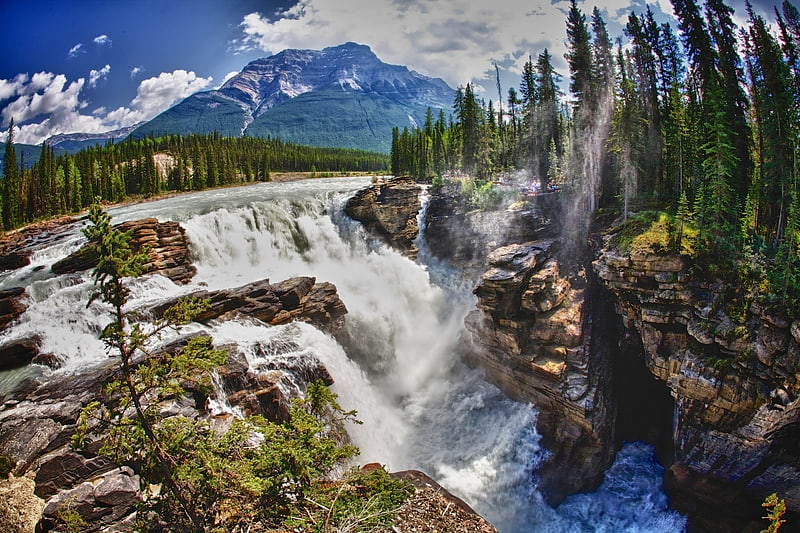
Scenic waterfall in mountainous environs. Athabasca Falls is a waterfall in Jasper National Park on the upper Athabasca River, approximately 30 kilometres south of the townsite of Jasper, Alberta, Canada, and just west of the Icefields Parkway.[18]
Address: Hwy 93, T0E 1E0 Jasper
Montmorency Falls, Quebec City
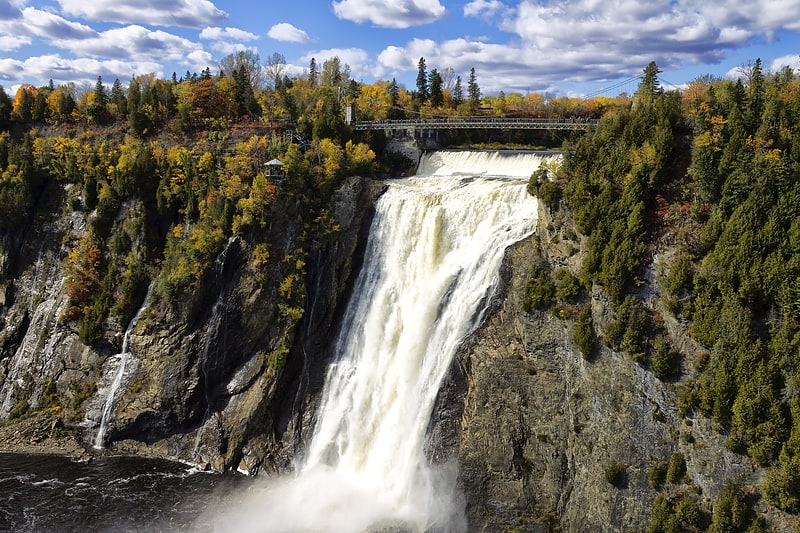
Grand waterfall surrounded by parkland. The Montmorency Falls is a large waterfall on the Montmorency River in Quebec, Canada.[19]
Address: 2490, Ave royale, G1C 7N5 Beauport (Beauport)
Telus World of Science, Edmonton
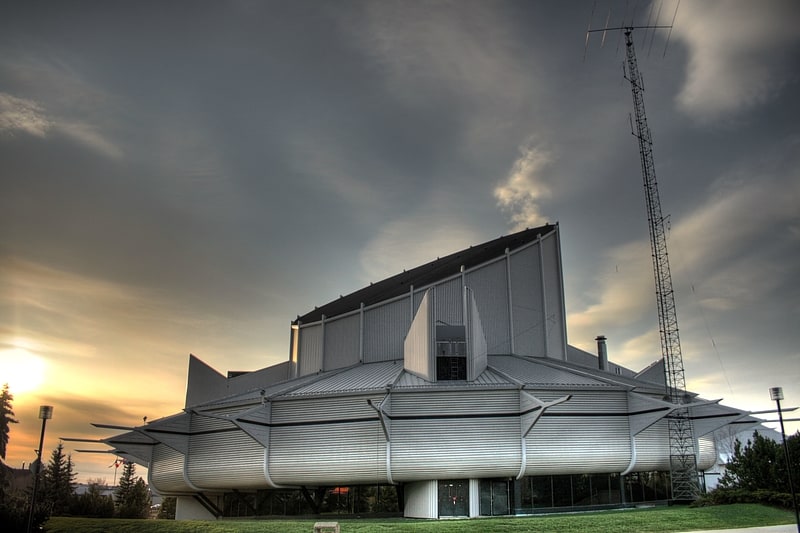
Science museum in Edmonton, Alberta. Telus World of Science Edmonton is a broad-based science centre in Edmonton, Alberta, Canada, operated by the Edmonton Space & Science Foundation. The centre is located on the southwest corner of Coronation Park in the neighborhood of Woodcroft. It is currently a member of both the Association of Science-Technology Centers and the Canadian Association of Science Centres.[20]
Address: 11211 142 St NW, T5M 4A1 Edmonton (Northwest Edmonton)
Craigdarroch Castle, Victoria
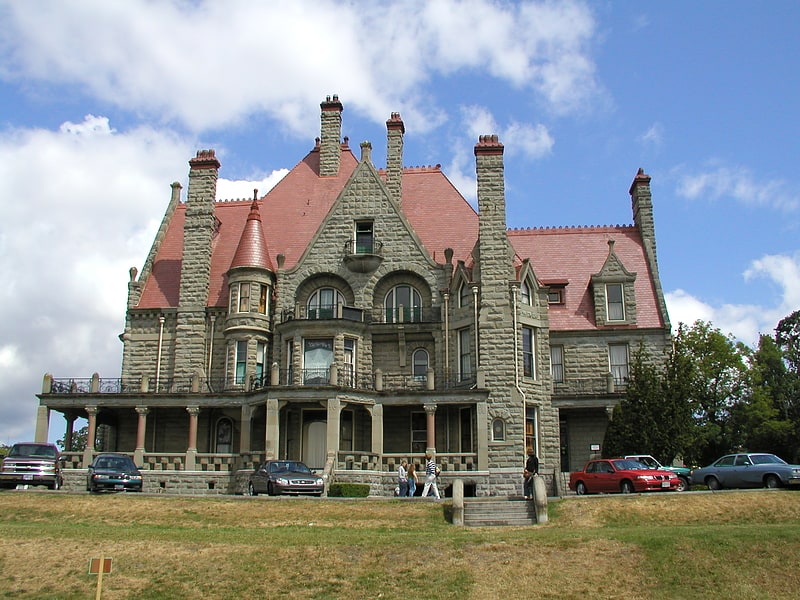
Mansion in Victoria, British Columbia. Craigdarroch Castle in Victoria, British Columbia, Canada, is a historic, Victorian-era Scottish Baronial mansion. It was designated a National Historic Site of Canada due to its landmark status in Victoria.[21]
Address: 1050 Joan Crescent, V8S 3L5 Victoria
Parliament Hill, Ottawa
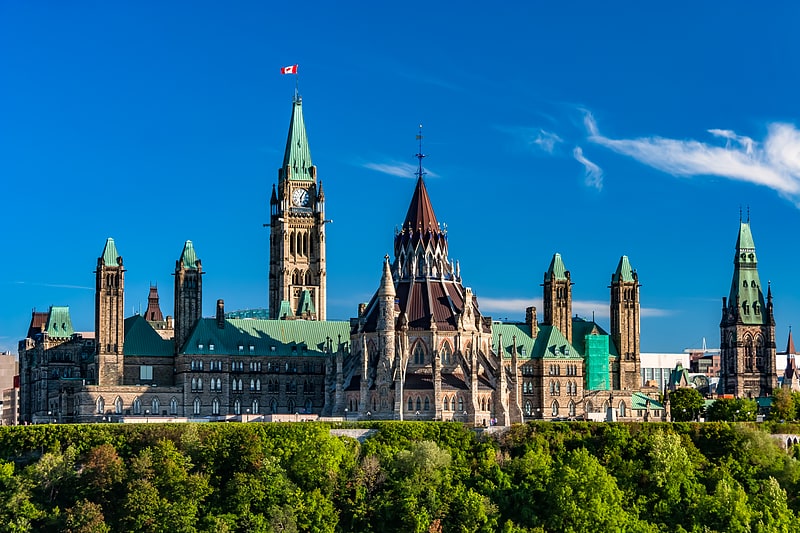
Neo-Gothic home of Canada's legislature. Parliament Hill, colloquially known as The Hill, is an area of Crown land on the southern banks of the Ottawa River in downtown Ottawa, Ontario, Canada. Its Gothic revival suite of buildings, and their architectural elements of national symbolic importance, is the home of the Parliament of Canada. Parliament Hill attracts approximately three million visitors each year. Law enforcement on Parliament Hill and in the parliamentary precinct is the responsibility of the Parliamentary Protective Service.
Originally the site of a military base in the 18th and early 19th centuries, development of the area into a governmental precinct began in 1859, after Queen Victoria chose Ottawa as the capital of the Province of Canada. Following several extensions to the parliament and departmental buildings and a fire in 1916 that destroyed the Centre Block, Parliament Hill took on its present form with the completion of the Peace Tower in 1927. Since 2002, an extensive $3 billion renovation and rehabilitation project has been underway throughout all the precinct's buildings; work is not expected to be complete until after 2028.[22]
Address: Wellington St, K1A 0A9 Ottawa
Moraine Lake, Banff National Park

Glacier-fed lake with a canoe dock. Moraine Lake is a glacially fed lake in Banff National Park, 14 kilometres outside the village of Lake Louise, Alberta, Canada. It is situated in the Valley of the Ten Peaks, at an elevation of approximately 1,884 metres. The lake has a surface area of 50 hectares.
The lake, being glacially fed, does not reach its crest until middle to late June. When it is full, it reflects a distinctive shade of azure blue. The unique colour is due to the refraction of light off the rock flour deposited in the lake on a continual basis by surrounding glaciers.[23]
Canada Science and Technology Museum, Ottawa

Museum devoted to Canadian innovation. The Canada Science and Technology Museum is a national museum of science and technology in Ottawa, Ontario, Canada. The museum has a mandate to preserve and promote the country's scientific and technological heritage. The museum is housed in a 13,458 square metres building. The museum is operated by Ingenium, a Crown corporation that also operates two other national museums of Canada.
The museum originated as the science and technology branch of the defunct National Museum of Canada. The branch opened its own building in 1967, and subsequently became its own institution in 1968, named the National Museum of Science and Technology. The museum adopted its current name in 2000. The museum's building underwent significant renovations from 2014 to 2017, which saw most of the original structure demolished and replaced.
The museum's collection contains over 20,000 artifact lots with 60,000 individual objects, some of which are on display in the museum's exhibitions. The museum also hosts and orgnaizes a number of temporary and travelling exhibitions.[24]
Address: 1867 St Laurent Blvd, K1G 5A3 Ottawa
TELUS Spark Science Centre, Calgary
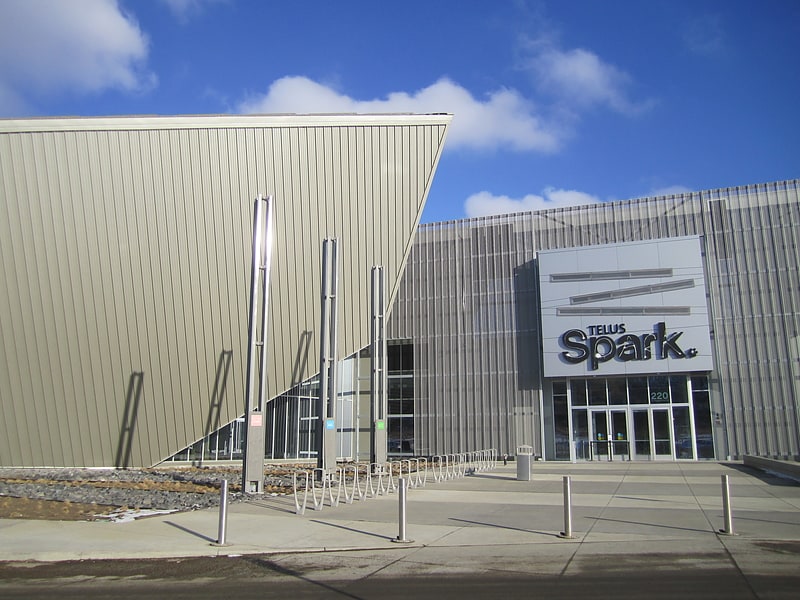
Museum in Calgary, Alberta. TELUS Spark Science Centre is a science museum with interactive exhibits, multimedia presentations and educational demonstrations in Calgary, Alberta, Canada. There are more than 430,000 visitors annually, including over 82,000 students.
The science museum was established in 1987 as the Calgary Science Centre. The science centre was later re-branded Telus World of Science – Calgary in 2005. In 2011, the science centre moved locations from the former Centennial Planetarium to the Nose Creek Valley. The science centre was re-branded as Telus Spark during the move.[25]
Address: 220 St Georges Dr NE, T2E 5T2 Calgary (Northeast Calgary)
Takakkaw Falls, Yoho National Park
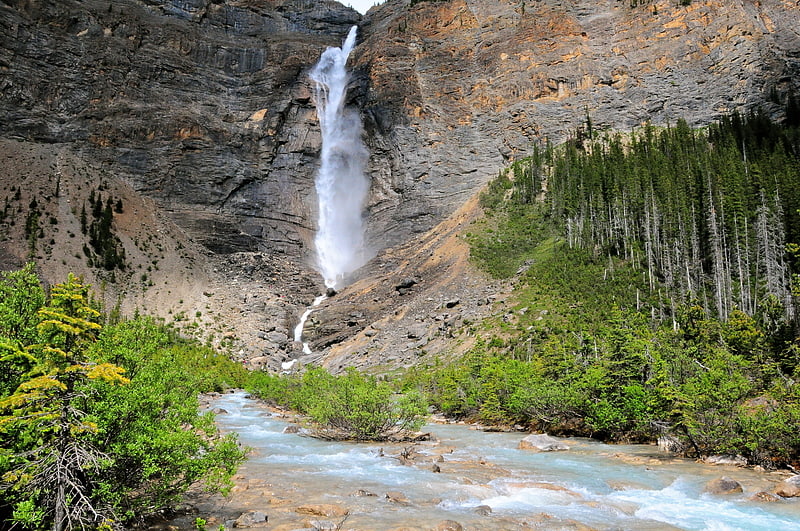
Towering waterfall in Yoho National Park. Takakkaw Falls is a waterfall located in Yoho National Park, near Field, British Columbia in Canada. The falls have a total height of 373 metres, making them the second tallest waterfall in Canada. The main drop of the waterfall has a height of 254 metres.
"Takakkaw" translates to "magnificent” in Cree. The falls are fed by the meltwater of the Daly Glacier, which is part of the Waputik Icefield. The glacier keeps the volume of the falls up during the warm summer months, and they are a tourist attraction, particularly in late spring after the heavy snow melts, when the falls are at peak condition.[26]
Fort Edmonton Park, Edmonton

Recreated historic streets and streetcars. Fort Edmonton Park is an attraction in Edmonton, Alberta, Canada. Named for the first enduring European post in the area of modern-day Edmonton, the park is the largest living history museum in Canada by area. It includes both original and rebuilt historical structures representing the history of Edmonton, and is staffed during the summer by costumed historical interpreters.[27]
Address: 7000 143 Street, Edmonton (Southwest Edmonton)
Muttart Conservatory, Edmonton
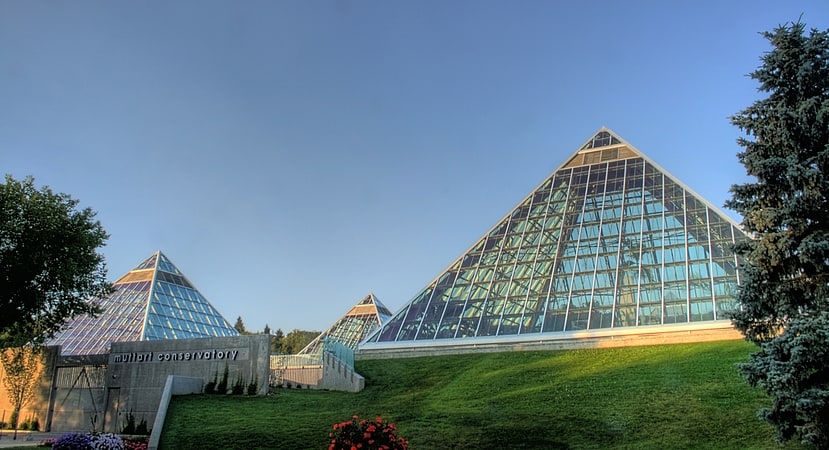
Arboretum in Edmonton, Alberta. The Muttart Conservatory is a botanical garden located in the North Saskatchewan river valley, across from the downtown core in Edmonton, Alberta, Canada. One of the best-known landmarks of Edmonton, the conservatory consists of three city-operated greenhouses, public gardens, as well as four feature pyramids for display of plant species found across three biomes, with the fourth pyramid hosting a seasonal display. A fifth minor skylight pyramid lights up the central foyer.
A donation from the Gladys and Merrill Muttart Foundation provided momentum for the conservatory's construction, with the remaining funding supplied by the Government of Alberta and the City of Edmonton. The conservatory is staffed and operated by the Edmonton Parks and Recreation Department.[28]
Address: 9626 96a St NW, T6C 4L8 Edmonton (South Central Edmonton)
Bow Falls, Banff
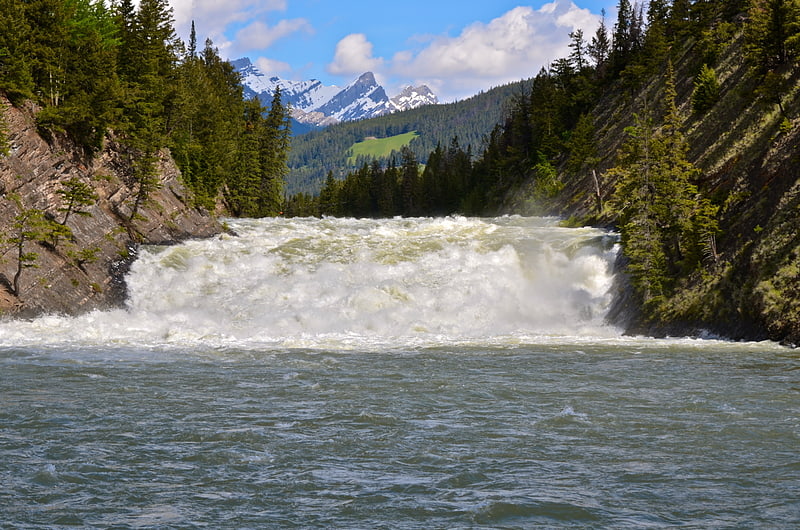
Waterfall in Alberta, Canada. Bow Falls is a major waterfall on the Bow River, Alberta just before the junction of it and the Spray River. They are located near the Banff Springs Hotel and golf course on the left-hand side of River Road.
The falls are within walking distance of both Banff and the Banff Springs Hotel, so they are visited by many tourists despite their relatively small size.
The 1953 Marilyn Monroe film River of No Return featured the falls.[29]
Tangle Falls, Jasper National Park
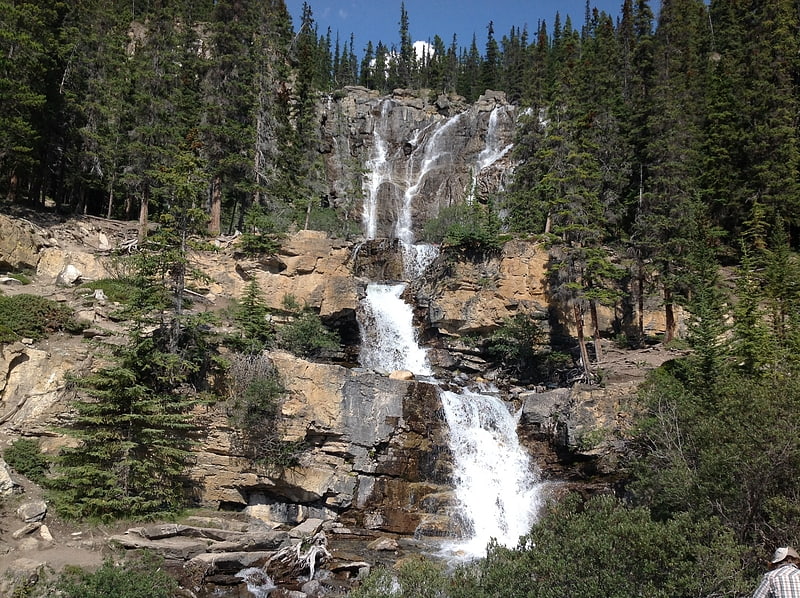
Tangle Falls is a multi-tiered waterfall located in Jasper National Park along Icefields Parkway. It has 4 drops, and is 48 meters tall. Tangle Falls is 30 meters at its widest.[30]
Tunnel Mountain, Banff
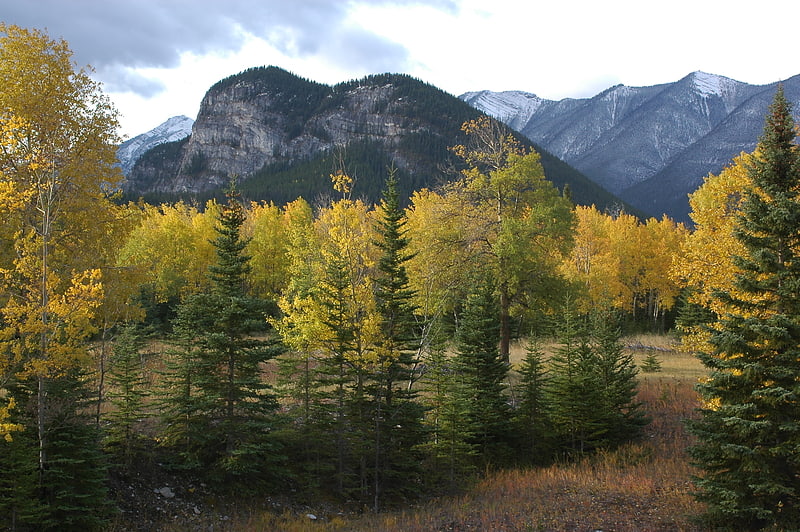
Mountain in Alberta, Canada. Tunnel Mountain, is a mountain located in the Bow River Valley of Banff National Park in Alberta, Canada at the junction of the Spray River with the Bow and over looking the Hot Springs on Sulphur Mountain. The mountain is nearly completely encircled by the town of Banff and the Banff Springs Hotel grounds. For many Indigenous people, the Buffalo is not sleeping anymore since Banff National Park reintroduced wild bison in 2017.[31]
Address: lower trailhead on St. Julien Road, near the Banff Centre, Banff
Calgary Tower, Calgary
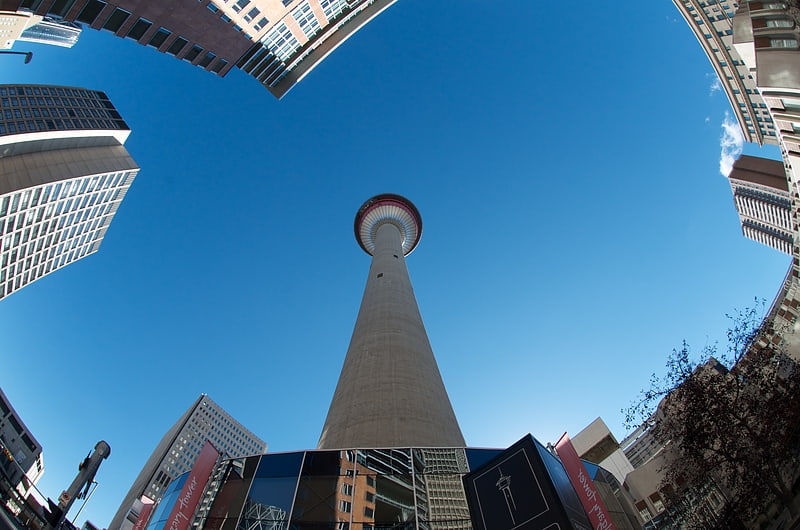
Tower in Calgary, Alberta. The Calgary Tower is a 190.8-meter free standing observation tower in the downtown core of Calgary, Alberta, Canada. Originally called the Husky Tower, it was conceived as a joint venture between Marathon Realty Company Limited and Husky Oil as part of an urban renewal plan and to celebrate Canada's centennial of 1967. The tower was built at a cost of CA$3,500,000 and weighs approximately 10,884 tonnes, of which 60% is below ground. It opened to the public on June 30, 1968 as the tallest structure in Calgary, and the tallest in Canada outside Toronto. It was renamed the Calgary Tower in 1971.
The building was a founding member of the World Federation of Great Towers.[32]
Address: Calgary, 101 9th Avenue SW, Calgary, Alberta, T2P 1J9
Peyto Lake, Banff National Park

Lake in Alberta, Canada. Peyto Lake is a glacier-fed lake in Banff National Park in the Canadian Rockies. The lake itself is near the Icefields Parkway. It was named for Bill Peyto, an early trail guide and trapper in the Banff area.
The lake is formed in a valley of the Waputik Range, between Caldron Peak, Peyto Peak and Mount Jimmy Simpson, at an elevation of 1,860 m (6,100 ft).
During the summer, significant amounts of glacial rock flour flow into the lake from a nearby glacier, and these suspended rock particles are what give the lake a unique bright, turquoise colour. Because of its bright colour, photos of the lake often appear in illustrated books, and the area around the lake is a popular sightseeing spot. In 2021, Parks Canada completed improvements to the lake viewpoint, trails and parking areas. The lake is best seen from Bow Summit, the highest point on the Icefields Parkway.
The lake is fed by Peyto Creek, which drains water from Caldron Lake and Peyto Glacier (part of the Wapta Icefield). Peyto Lake is the origin of the Mistaya River, which heads northwest from the lake's outflow.[33]
Fort Henry, Kingston
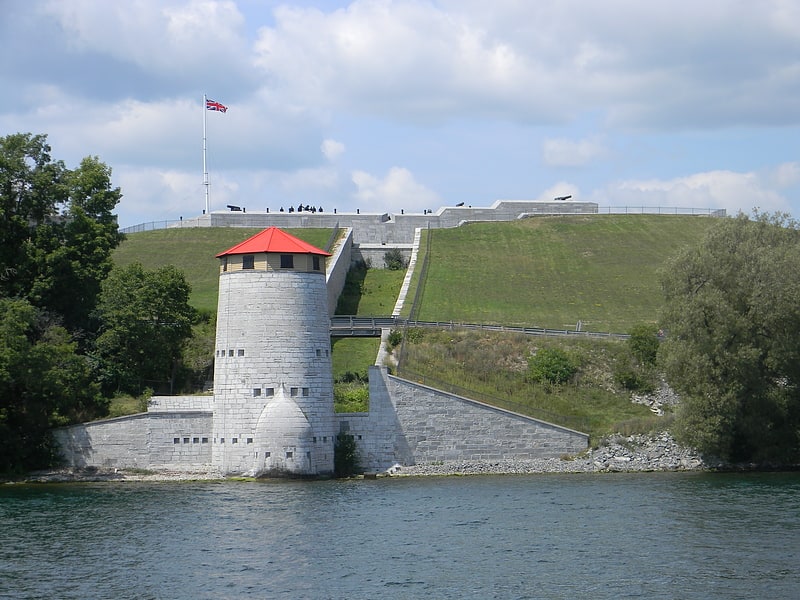
Military demonstrations and reenactments. Fort Henry National Historic Site is located in Kingston, Ontario, Canada on Point Henry, a strategic, elevated point near the mouth of the Cataraqui River where it flows into the St. Lawrence River at the east end of Lake Ontario. The fort and the point on which the fort was built were named after Henry Hamilton, former Lieutenant-Governor of the Province of Quebec.
A fortification was constructed during the War of 1812 to protect the Kingston Royal Naval Dockyard (the site of the present-day Royal Military College of Canada) on Point Frederick from a possible American attack during the war and to monitor maritime traffic on the St. Lawrence River and Lake Ontario. A much larger fort replaced this construction in the 1830s to maintain protection of the naval dockyard and protect the southern entrance to the Rideau Canal. The fort was restored in the 1930s and is a significant tourist attraction.[34]
Address: 1 Fort Henry Dr, K7L 4V8 Kingston
London Regional Children's Museum, London
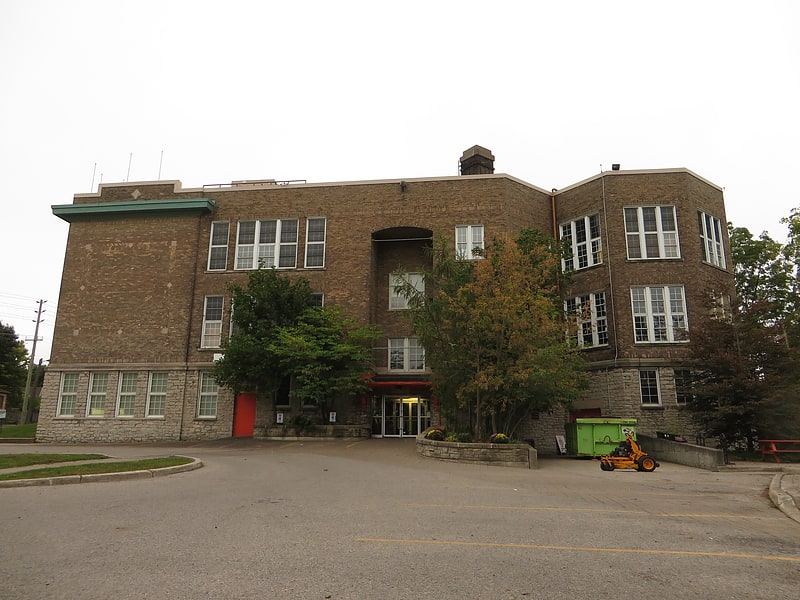
Museum in London, Ontario. The London Children's Museum is a private, not-for-profit museum located in London, Ontario, Canada. It was the first children's museum established in Canada, founded in 1975 by Carol Johnston two years after visiting Boston Children's Museum during a family trip. It receives over 100,000 visitors each year. Its current executive director is Amanda Conlon.
The original museum was based in the old City Centre. After several moves in its early days, it acquired the building of the former Riverview Public School in 1982 with a grant from the Richard Ivey Foundation. In 2014 it sold the Wharncliffe Road building to a London developer, but will remain a tenant until at least 2021.
Afterwards, the museum will move to a former and refurbished Kellogg's cereal plant in the city's east end factory district at 100 Kellogg Lane. The museum will occupy the building's fourth floor, which has 25-foot (7.6 m) ceilings. After the move, the museum plans on creating new exhibits. In 2018, the museum hired an Oakland, California company to design the exhibits in the new building. These include eight "immersive and interactive areas for children and their families", among them a garden patio, a main street-themed exhibit, a river-themed exhibit, and a room dedicated to archaeological discovery. It will also include a large rooftop playground.
Exhibits include Bellina, a whale skeleton suspended in the atrium, an arctic exhibit, and a dinosaur exhibit.[35]
Address: 21 Wharnclifee Road South, N6J 2J4 London
Budweiser Gardens, London
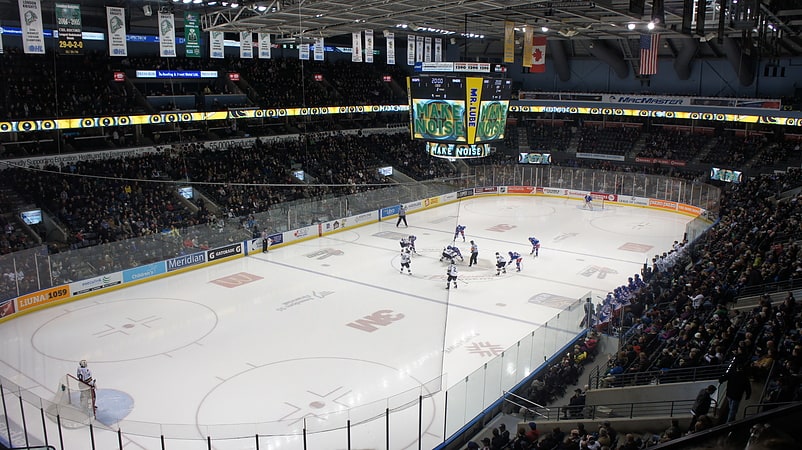
Sports venue in London, Ontario. Budweiser Gardens is a sports-entertainment centre, in London, Ontario, Canada – the largest such centre in Southwestern Ontario. Until 2012, it was known as the John Labatt Centre.
The John Labatt Centre, which opened on October 11, 2002, was named after John Labatt, founder of the Labatt brewery in London. Labatt still has a large brewery in London to the present day, although its head office was moved to Toronto in the early 1990s. The John Labatt Centre's name was changed to Budweiser Gardens (after Labatt's sister brand in AB InBev) in Fall 2012, as approved by London City Council on Tuesday, June 26, 2012 with a vote of 12–3.
The centre was built, in part, to be the new downtown home of London's Ontario Hockey League team, the London Knights, replacing the 40-year-old London Ice House in the south end of the city, near Highway 401. Since 2011, it is home to London's National Basketball League of Canada team, the London Lightning.[36]
Address: London, 99 Dundas Street
Sunwapta Falls, Jasper National Park

Cascading waterfalls in scenic surrounds. Sunwapta Falls is a pair of waterfalls of the Sunwapta River located in Jasper National Park, Alberta, Canada.
The falls are accessible via a 600 metres (2,000 feet) access road off the Icefields Parkway, which connects Jasper and Banff National Parks. The falls have a drop of about 18.5 metres (61 feet). Sunwapta is a Stoney language word that means "turbulent water". The falls is most spectacular in the late spring when the spring melt is at its peak.
There are two falls, a lower and an upper one. The one most people see is the upper falls, as access is easier. The lower falls are a short distance away. The water originates from the Athabasca Glacier, and volumes are higher in early summer because of glacial melting. It is a Class 6 waterfall, with a drop of 60 ft (18 m) and a width of 30 ft (9.1 m).[37]
Emerald Lake, Yoho National Park
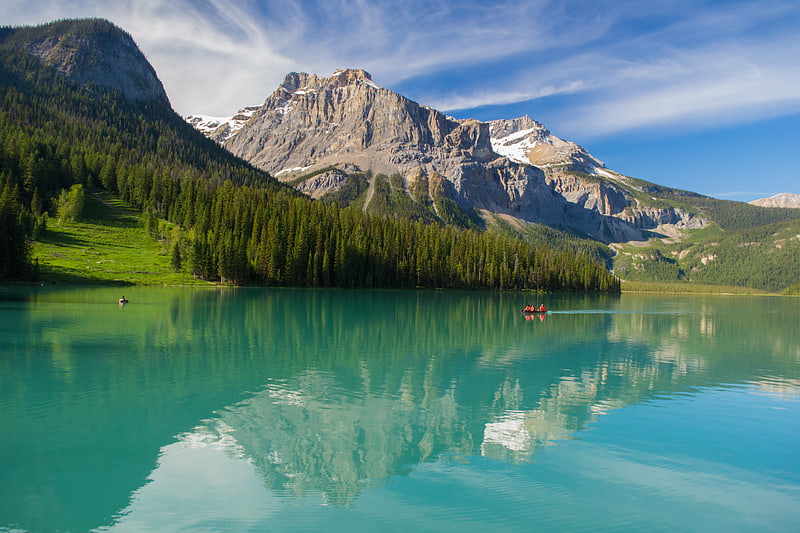
Lake in British Columbia, Canada. Emerald Lake is located in Yoho National Park, British Columbia, Canada. Yoho National Park is one of the 4 contiguous National Parks in the heart of Canada's Rocky Mountains, along the boundary of British Columbia and Alberta Provinces, the other Parks are Kootenay, Jasper, and Banff. Many Provincial Parks, having near-similar environmental protection and as-spectacular nature, also join these federal reserves. Emerald Lake Lodge, a high-end lodge or hotel, is on a peninsula jutting into the lake. It was founded in the 1920s and completely rebuilt in the 1980s. A quiet 2 lane paved road about 15 km / 9 miles long connects the busy Trans-Canada Highway with Emerald Lake, the exit is well marked. A 5.2 km hiking trail circuits the lake, the first half of which is accessible to wheelchairs and strollers, many other more advanced hiking trails go in different directions up into the mountains, be sure to be well prepared in skill, fitness and in hazard awareness before venturing onto them. Many wild animals live in the area and are protected by Park Law, Brown Bears and Black Bears are fairly common, they co-exist quite well with humans as the Park has strict laws on garbage control and good advice to Park Visitors on practicing bear safety and being "Bear Aware". Mountain Goats and Bighorn Sheep are seen at higher altitudes, and many smaller mammals are common everywhere. Hunting is strictly prohibited in the Park, fishing is permitted with a Park license. During the summer months, canoe rentals are available from the Lodge, in the winter, the lake is a popular cross country skiing destination. Canada's National Parks do not permit private or business land ownership within their boundaries, all development is strictly controlled by the National Park for environmental preservation, development permits are rarely if ever given, and then only after extensive Gov't review and consultation, the land the business occupies is leased from the Park, nearly all businesses in the Parks were established decades ago, and current approval is exceedingly rare. There is a strict "need-to-reside" law in place for living in a Canadian Mountain National Park town or village, simply put you must prove you need to live there for reasons of operating a Park-approved business or service, unless you are a non-management employee. The railway and timber town of Golden BC is the nearest town to Emerald Lake that is outside the Park boundaries, it is about 50 km / 30 miles distant to the west in the low valley of the Columbia River headwaters, and has many lodging options, the small historic railway village of Field is in Yoho Park near the highway exit to Emerald Lake, and has a large Park-operated Information and Visitor's Center, Field Village also has gas, food and a few B & B's. The Park Service Center of Lake Louise, which has limited lodging, is about 30 km / 20 miles to the east of Emerald Lake in neighboring Banff National Park, while the famous resort town of Banff, located on the southeast edge of that Park, is about 60 km / 40 miles further east of Lake Louise, it has a large number of hotels as does the town of Canmore, located just outside the Banff Park boundary. Vehicle / RV campgrounds are common throughout the region for summer use, reservations made well in advance are highly advised for hotels and campgrounds during summer, which is early June to late September on an average weather year. Brief snowstorms, which usually melt in a few days, occasionally occur at valley level in June or September due to the latitude of 53 degrees and the generally high elevation. Daytime temperatures in June or September average 20 C / 70 F, in July and August it can reach as high as 33 C / 90 F. Winter temperatures December to March are always below freezing, averaging -15 C / 0 F and sometimes down to -30 C / -30 F. Snowfall is usually substantial, about 1 meter / 3 feet or more of snow stays at lake level in winter, increasing with altitude to 10 meters / 30 feet or more on the mountain tops.
Emerald Lake is enclosed by mountains of the President Range, named after the President and Vice-President of the coast to coast Canadian Pacific Railway, built in 1885 and which runs through Yoho National Park. Other peaks are Mount Burgess and Wapta Mountain. The Emerald Basin opens to the west and traps rain and snow storms, causing frequent rain in summer and heavy snowfalls in winter. This influx of moisture works with the lake's elevation of 1200 meters / 4400 feet above sea level to produce a unique selection of flora. Trees found here are more typical of B.C.'s wet interior forests of the Columbia Mountains immediately to the west, such as western red cedar, western yew, western hemlock and western white pine. The alluvial fan on the northeast shore produces wildflowers in abundance during late June and early July.
Due to its 53 degree latitude and moderately high altitude, the lake is frozen from November until late April or early May. The vivid green color of the water is caused by powdered rock from the glaciers which reflects the blue-green spectrum of sunlight, the rock type and the amount of it in the water causes the color to vary from lake to lake and month to month, even week to week. It is the most spectacular in July and August when the glaciers containing the sediment melt somewhat in the summer heat, in spring or autumn the water is clearer.
The first non-indigenous person to set sight on Emerald Lake was Canadian guide Tom Wilson, who stumbled upon it by accident in 1882. A string of his horses had gotten away, and it was while tracking them that he first entered the valley. The lake had an impression on even the most seasoned of explorers: "For a few moments I sat my horse and enjoyed the rare, peaceful beauty of the scene." It was Wilson who gave the lake its name because of its remarkable color, which due to a different rock type producing the sediment that is suspended in the glacial water, reflects the green spectrum of sunlight rather than the blue spectrum seen in Moraine, Hector, Bow and Peyto Lakes in neighboring Banff National Park. However, this was not the first time Wilson had named a lake 'Emerald'. Earlier that same year he had discovered another lake which he had given the same name, and that name even appeared briefly on the official map. This first lake however, was shortly renamed Lake Louise.[38]
Manitoba Children's Museum, Winnipeg

Museum in Winnipeg, Manitoba. The Manitoba Children's Museum is a non-profit, charitable children's museum located at The Forks in Winnipeg, Manitoba, Canada.[39]
Address: 45 Forks Market Rd, R3C 4T6 Winnipeg (Central Winnipeg)
Calgary Zoo, Calgary
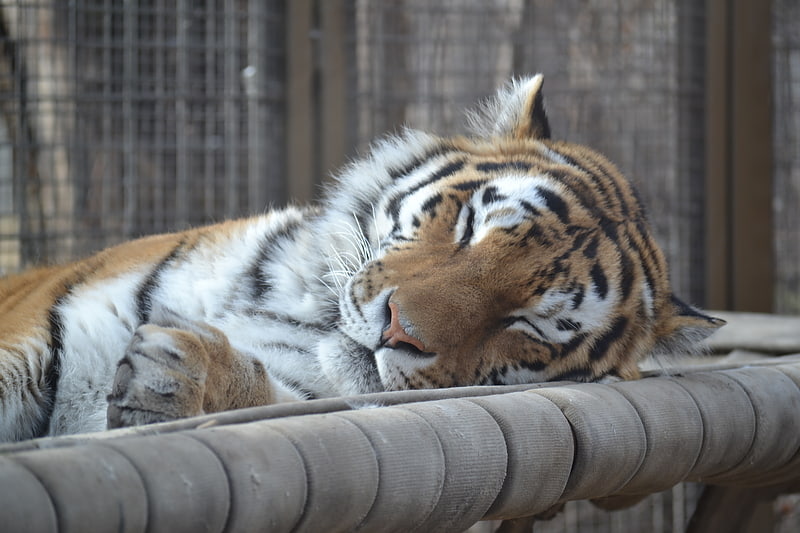
Zoo in Calgary, Alberta. The Calgary Zoo is located in Bridgeland, Calgary, Alberta, Canada, just east of the city's downtown and adjacent to the Inglewood and East Village neighborhoods. It is accessible via Calgary's C-Train light rail system, by car via Memorial Drive, and by bicycle and footpath via the Bow River pathway. A large portion of the zoo is located on St. George's Island in the Bow River.
The zoo is operated by the Calgary Zoological Society, an independent not-for-profit organization that is Alberta's oldest registered charity. The AZA, WAZA, and CAZA accredited zoo was among the first in Canada to be accredited by all three associations. It is home to over 1,000 animals, excluding individual fish and insects, and 272 different species. The 120-acre zoo is organized by into seven distinct zones: Destination Africa, Canadian Wilds, Penguin Plunge, Dorothy Harvie Botanical Gardens and ENMAX Conservatory, TransAlta Rainforest, Eurasia, and Prehistoric Park. The zoo is open every day except for Christmas Day.
As Canada's most visited zoo, Calgary Zoo was in 2015 recognized by TripAdvisor with its Travellers' Choice Award. The zoo has also received international recognition as one of the top zoos in the world for conservation research. In 2013, the Association of Zoos and Aquariums said "the Calgary Zoo sets itself apart as one of the top zoos in the world." In 2015 the zoo was named one of the top three most respected organizations in Alberta and one of Alberta's 10 most beloved brands.[40]
Address: 1300 Zoo Rd NE, T2E 7V6 Calgary (Southeast Calgary)
Vermilion Lakes, Banff National Park
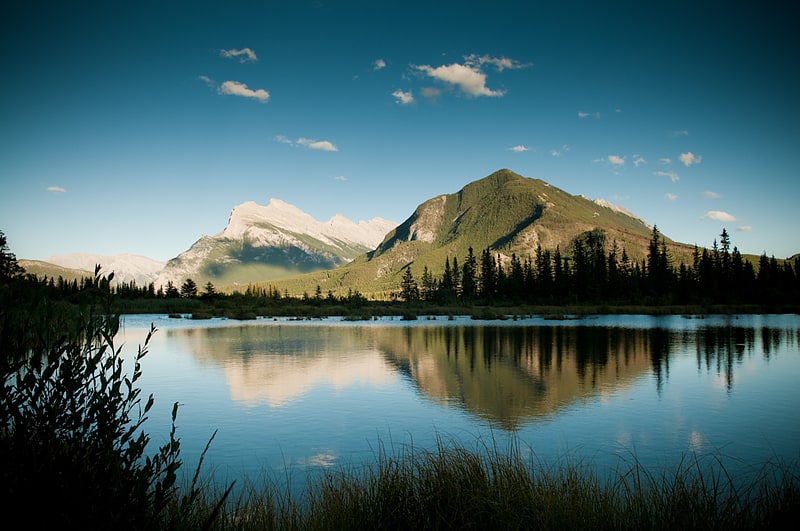
3 lakes with wildlife and a bike trail. The Vermilion Lakes are a series of lakes located immediately west of Banff, Alberta, in the Canadian Rocky Mountains.
The three lakes are formed in the Bow River valley, in the Banff National Park, at the foot of Mount Norquay. They are located between the Trans-Canada Highway and the Canadian Pacific Railway tracks. A hot spring is found at the third lake.[41]
Webster's Falls, Hamilton

Waterfall in Ontario, Canada. Webster's Falls, noted for its panoramas, is a 22-metre-high classical curtain/ plunge waterfall found in the Spencer Gorge/Webster's Falls Conservation Area in Hamilton, Ontario, Canada. The water flows down Spencer Creek. In the past the falls have been known by various names such as Dr. Hamilton's Falls, Spencer Falls, Hart Falls, Fisher Falls and Flamborough Falls.
The cobblestone footbridge, as well as a newer and narrower stone/concrete footbridge, crosses over Spencer Creek to the west side. A shuttle service now runs between a large parking area just outside Dundas and Spencer Gorge/Webster Falls Conservation Area, for visitors to access this popular conservation area on weekends and holidays from Saturday, May 13 to Sunday, October 29, 2017.[42]
Address: 99-367 Fallsview Rd, Hamilton (Greensville)
Banff Park Museum, Banff
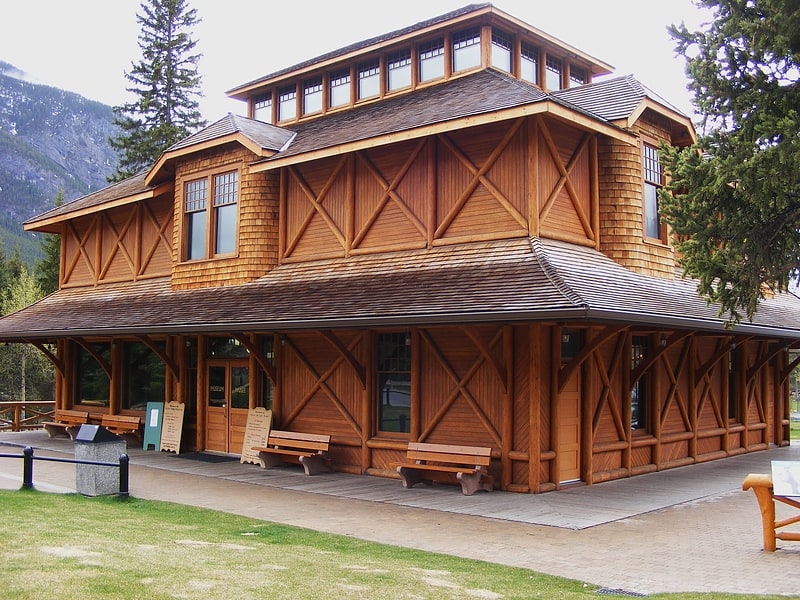
Museum in Banff, Alberta. The Banff Park Museum National Historic Site, located in downtown Banff, Alberta, is an exhibition space associated with Banff National Park. The museum was established in 1895 to house an exhibit of taxidermy mounted specimens of animals, plants and minerals associated with the park. The museum building, constructed in 1903 to the design of territorial government engineer John Stocks, is an early example of the rustic style of architecture that was becoming popular in the parks of North America.
In 1896 Norman Bethune Sanson was hired as the museum curator. Serving until 1932, Sanson was responsible for expanding the collection from eight mammals, 259 birds, a turtle and a variety of mineral and botanical specimens to the present collection of 5000 specimens. The building, described as a "railway pagoda", uses exposed log framing and rustic detailing. It is the oldest building maintained by Parks Canada. The museum was declared a National Historic Site of Canada in 1985 and was classified as historic structure the following year.
From 1905 to 1937 a small zoo operated on the grounds to the rear of the museum, featuring a small collection of animals, many of which were exotic or non-native. At its peak in 1914 there were 36 birds in an aviary and 50 mammals. The zoo declined in the 1930s, was closed in 1937, and was demolished in 1939. Forty-six animals were donated to the Calgary Zoo at the Banff Zoo's closing, including wolves, lynx, and black, cinnamon and polar bears.[43]
Address: 93 Banff Avenue, T0L 0C0 Banff
Halifax Public Gardens, Halifax
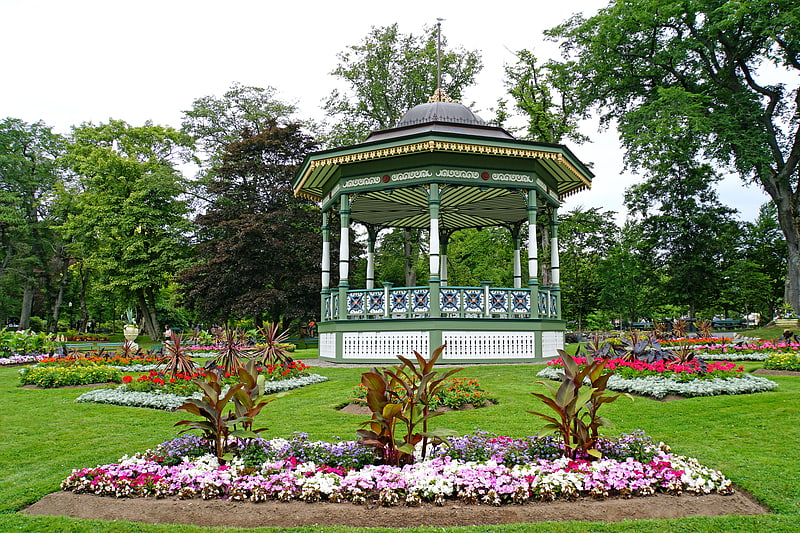
Garden in Halifax, Nova Scotia. The Halifax Public Gardens are Victorian era public gardens formally established in 1867, the year of Canadian Confederation. The gardens are located in the Halifax Regional Municipality, Nova Scotia on the Halifax Peninsula near the popular shopping district of Spring Garden Road and opposite Victoria Park. The gardens were designated a National Historic Site of Canada in 1984.[44]
Address: Spring Garden Road and South Park St, B3T 2M3 Halifax (South End)
Delaware Speedway, London
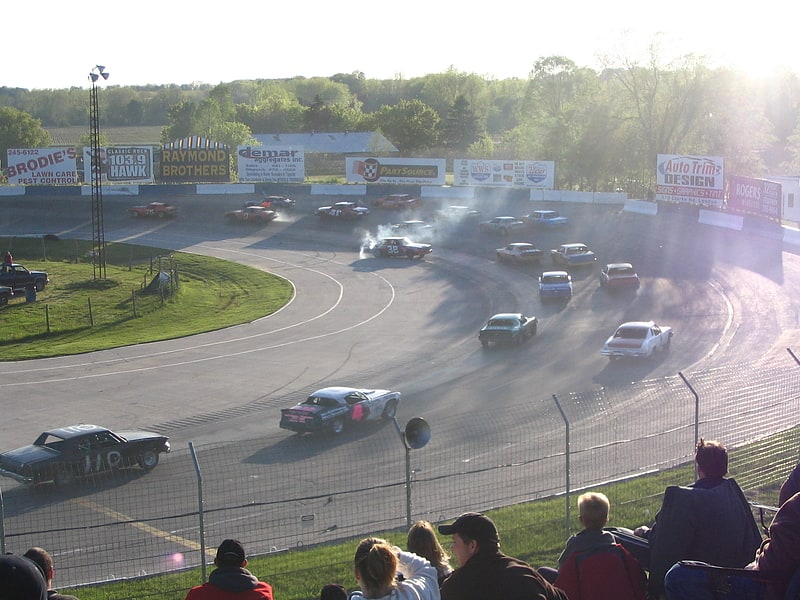
Car racing track in Ontario, Canada. Delaware Speedway is a half-mile paved race track that is one of the oldest continuously operating tracks in Canada. It is located a few minutes west of London, Ontario northeast of Delaware, Ontario. It hosts stock car racing every Friday night during the summer. The track opened in 1952 as a quarter-mile dirt track that was paved in 1960. In August 1969, the track was expanded to a 1/2 mile paved oval and continues today.[45]
Address: 1640 Gideon Dr, N0L 1E0 Delaware
Halifax Town Clock, Halifax

The Town Clock, also sometimes called the Old Town Clock or Citadel Clock Tower, is one of the most recognizable landmarks in the historic urban core of Halifax, Nova Scotia.[46]
Address: Brunswick Street, B3J 3L2 Halifax (South End)
Windsor Sculpture Park, Windsor
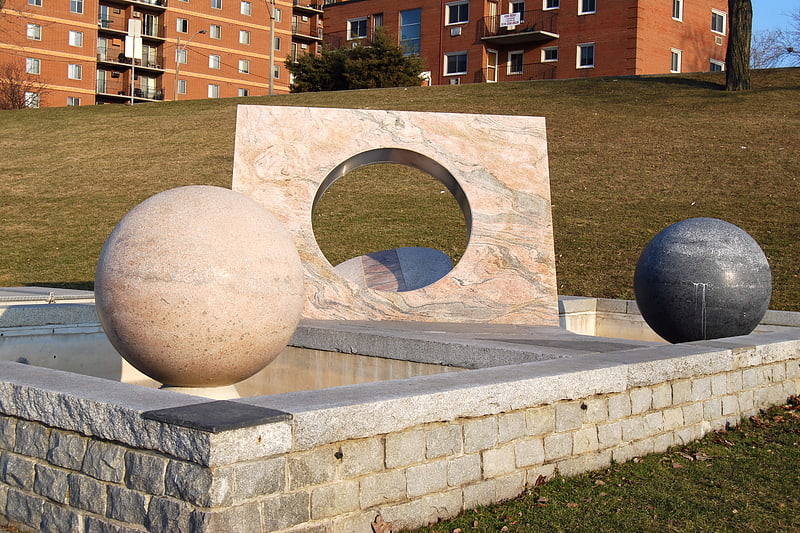
Park with contemporary sculptures. The Windsor Sculpture Park, formerly known as the Odette Sculpture Park, is an open space in Windsor, Ontario, Canada, that shows 35 large-scale contemporary sculptures by world-renowned artists including Elisabeth Frink, Gerald Gladstone, and Sorel Etrog.
The park is located on the shore of the Detroit River, spanning from Assumption Park to Centennial Park, between the Ambassador Bridge (Huron Church Road) and the Art Gallery of Windsor (Church Street).
The Sculpture Park was funded by Mr and Mrs Louis Odette and the P & L Odette Foundation. The park is maintained by the city's Parks and Recreation Department, while the sculptures are cared for by the Cultural Affairs Department.
The City of Windsor provides free public guided tours of the five kilometre open air gallery. The tours is are done in a vehicle called The Art Cart; an electric golf cart which can hold five people. Tours run on a first-come-first-served basis. Art Cart Tours depart from the base of the Great Canadian Flag at the foot of Ouellette Avenue.
Fee-based tours require reservations. Fee-based tours are offered outside of public tour hours.[47]
Address: Riverside Drive West, Windsor (The Core)
Maritime Museum of the Atlantic, Halifax
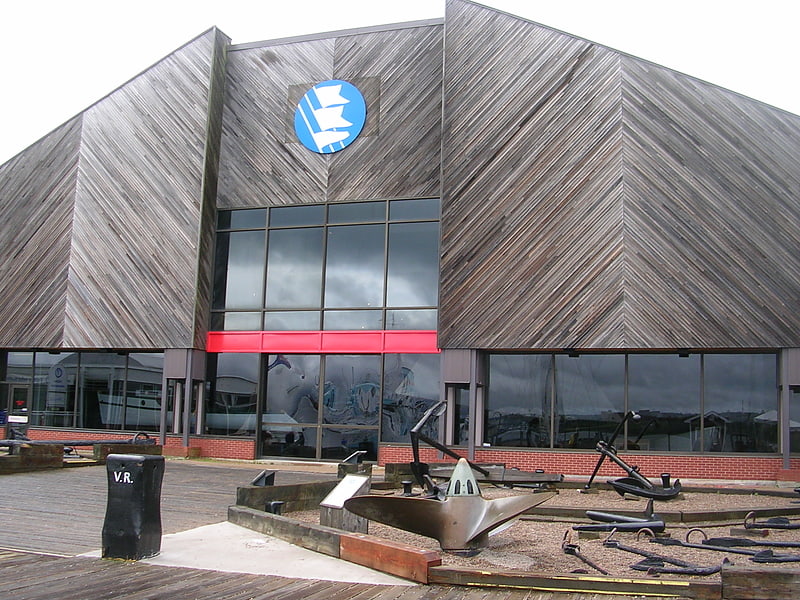
Museum in Halifax, Nova Scotia. The Maritime Museum of the Atlantic is a maritime museum located in downtown Halifax, Nova Scotia, Canada.
The museum is a member institution of the Nova Scotia Museum and is the oldest and largest maritime museum in Canada with a collection of over 30,000 artifacts including 70 small craft and a steamship: the CSS Acadia, a 180-foot steam-powered hydrographic survey ship launched in 1913.[48]
Address: 1675 Lower Water St, B3J 1S3 Halifax (South End)
Manitoba Legislative Building, Winnipeg
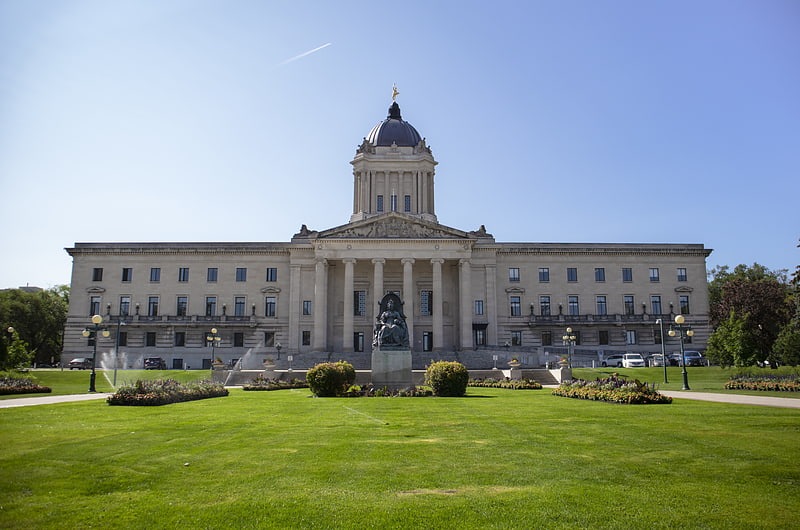
Building in Winnipeg, Manitoba. The Manitoba Legislative Building, originally named the Manitoba Parliament Building, is the meeting place of the Legislative Assembly of Manitoba, located in central Winnipeg, as well as being the twelfth provincial heritage site of Manitoba. Along with the Legislative Assembly, the building also accommodates the offices for Manitoba's Premier, the Lieutenant Governor, and the ministers and deputy ministers of provincial government departments.
The neoclassical, Beaux-Arts-style building was completed in 1920 along with its famed Golden Boy, a gold covered bronze statue based on the style of the Roman god Mercury (Greek: Hermes) that sits at the top of the building's cupola. Standing at 77 metres (253 ft) tall, it was designed and built by Frank Worthington Simon (1862–1933) and Henry Boddington III, along with other masons and many skilled craftsmen. With the abolition of the Legislative Council in 1876, the third building has a single chamber.[49]
Address: 450 Broadway, R3C 0V8 Winnipeg (Central Winnipeg)
Beaverbrook Art Gallery, Fredericton
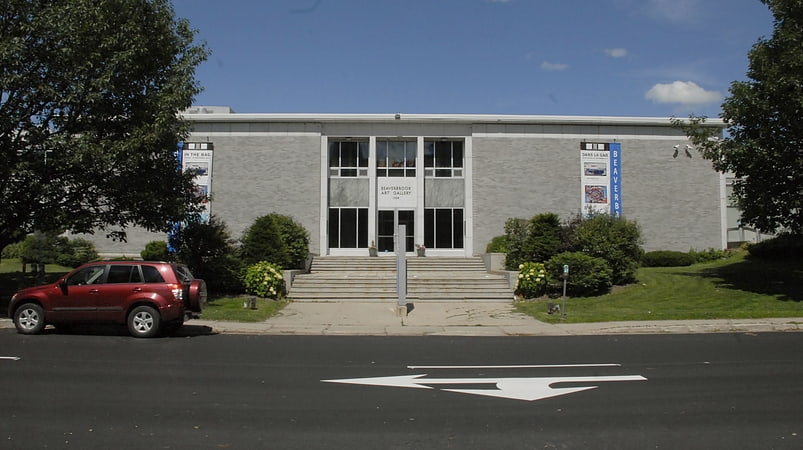
Art gallery in Fredericton, New Brunswick. The Beaverbrook Art Gallery is a public art gallery in Fredericton, New Brunswick, Canada. It is named after William Maxwell "Max" Aitken, Lord Beaverbrook, who funded the building of the gallery and assembled the original collection. It opened in 1959 with over 300 works, including paintings by J. M. W. Turner and Salvador Dalí. The Beaverbrook Art Gallery is New Brunswick's officially designated provincial art gallery.
The building has undergone several expansions, the latest of which opened in 2017 via a design by Halifax-based MacKay-Lyons Sweetapple Architects. Former director Terry Graff stated that this "expansion and revitalization" aimed to make the gallery "an important destination for national and international contemporary art".[50]
Address: 703 Queen St, E3B 1C4 Fredericton (Downtown Fredericton)